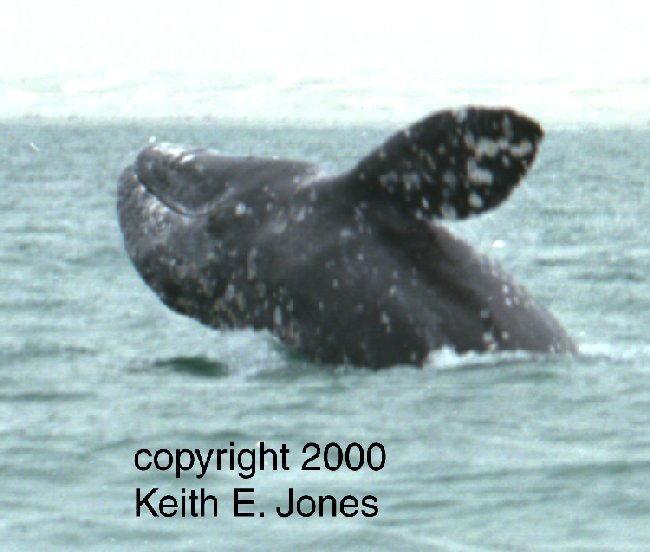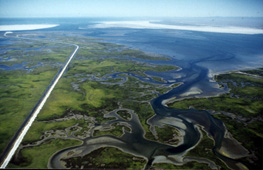 |
 |
 |
 |
 |
 |
 |
Gray Whale Migration Update: February 21, 2001
Today's Report Includes:
- Watching Whales in the Nursery Lagoons: Challenge Question #3
- Still Swimming South
- Thar' She Blows! Challenge Question #4
- Turnaround Day is Coming: Challenge Question #5
- Ideal Nurseries: Response to Challenge Question #1
- Got Milk? Response to Challenge Question #2
|
Gray Whale Migration Route |
Down near the Mexican nursery lagoons of Baja California*, hotels and boats are filling up with tourists eager to see the friendly whales. In Laguna Ojo de Liebre, Keith Jones took this baby's photo.
 |
What's it like in the lagoons when hundreds of whales are there? You'll enjoy Kristen's tales about nursery life in another lagoon, Laguna San Ignacio:
Read Kristen's observations, then come back and answer:
Challenge Question #3:
"Why is it best for the whale mothers and babies to stay apart from other whales in the lagoon?"
(To respond to this question, please follow the instructions below.)
Still Swimming South
Nancy Black of Monterey Bay Whale Watch (36.37N,-121.54W) reports "a lot of pods still going south." In fact, Nancy observes, "We're seeing a lot more going south this time of year than in previous years. On a 3-hour whale-watching trip, we're still seeing 15 whales on average, traveling in groups of two or three. This year's migration seems even later than last year's. There wasn't a peak or high spike in January like we usually see. The migration seems to be lasting longer and spreading out more than in most years." Nancy hasn't spotted any northbound whales yet this year, but she explains why that might be so: "The weather hasn't been so great, and the northbound whales are usually a little farther out." Visit their Web site to see what they're counting each day:
Monterey Bay Whale Watch--Marine Mammal Sightings
 |
The gray whale migration isn't easy to track. Although most of the world's estimated 26,000 gray whales migrate past California, census takers spot only a small proportion. Sure, whales are big and usually travel near shore, but some days the weather is bad and whales are hard to see. On other days they may travel farther offshore, especially southbound, so more northbound whales are counted each year. And some folks might not be quite sure what they're looking at. This photo offers a clue that whales are out there. Can you guess the clue? You'll find out more when you read our whale watching tips:
Then come back and answer:
Challenge Question #4
"What causes a whale's blow?"
(To answer this question, please follow the instructions below.)
Turnaround Day is Coming
Closer to the southern end of the migration route, the folks from the American Cetacean Society's (ACS) census station on Palos Verde Peninsula (33.44N,-118.24W) are reporting a few northbound grays--19 this season up to Feb. 19. The first northbound gray whale was spotted December 12! But southbound whales still outnumber the northbound ones. On February 19, seven southbound grays and 4 northbound were counted. That means "turnaround day" hasn't yet arrived. Alisa Schulman-Janiger of the ACS explains turnaround day as the date when more northbound whales are seen than southbound whales. Alisa thinks the turnaround may occur sometime in the next week. What else can we expect in the next few weeks? Alisa said, "The peak for the non cow/calf northward migration is usually the last of February up to mid-March. But we don't expect mothers and calves until about six weeks after the peak of northbound non cow/calf whales."
Challenge Question #5
"When do you predict the first gray whale will be sighted in the Gulf of Alaska, near Kodiak?"Clues:
1. The location and date of the first gray whale is stated above.2. Gray whales migrate at approximately 3-5 mph.
(To answer this question, please follow the instructions below.)
Mark your calendars and watch our upcoming reports to see what the ACS census numbers show. You can also watch
the census sightings each day by visiting the ACS Web site:
Ideal Nurseries: Response to Challenge Question #1
 |
"What are at least three reasons why Mexico's lagoons make such good whale nurseries? Why is each reason important to gray whales during their breeding and calving season?"
Team 7B from Iselin Middle School in Iselin, New Jersey did their reading and thinking. They gave these reasons:
"One reason why Mexico's lagoons make such good whale nurseries is because the warm waters of the shallow lagoons help newborn babies, which are relatively blubberless, conserve body heat. Also the gray whale's predator, the orcas, do not care for the shallow water and narrow entrance of the lagoons. As a result the gray whales have an advantage over them. Since the lagoon's entrances are narrow and there are many sandbars, only very experienced boaters can drive through the area. Without many boaters the whales benefit because they have more space and don't have to worry about watching out for anything that can harm them or their young."
Besides being warm, shallow, and free from many boaters and killer whales, the Baja lagoons are very salty. Salty water means buoyancy, and buoyancy makes it easier for the calves to float and nurse.
Got Milk? Response to Challenge Question #2
"About how much will a calf weigh by the time it is two months old and begins the long migration north? Why is this weight gain important?"
A newborn calf weighs about 2000 pounds at birth. If the calf gains about 60 pounds daily over 60 days (two months of age), that's 3600 pounds added to the birth weight of 2000--or about 5600 pounds total. Much of that weight gain is a thick layer of blubber to supply warmth and energy for the baby whale on the trip north into colder waters. During the swim north, the calf will continue to nurse and grow.
How to Respond to Today's Challenge Questions:
IMPORTANT: Answer only ONE question in each e-mail message.
1. Address an e-mail message to: jn-challenge-gwhale@learner.org
2. IMPORTANT: In the Subject Line of your message write: Challenge Question #3 (or #4 or #5).
3. In the body of the message, answer ONE of the questions above.
The Next Gray Whale Migration Update Will Be Posted on March 7, 2001
Copyright 2001 Journey North. All Rights Reserved. Please send all questions, comments, and suggestions to our feedback form
 |
 |
 |
 |
 |
 |


